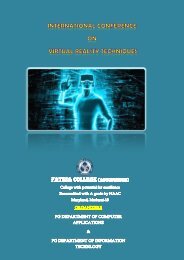combinepdf (5)
You also want an ePaper? Increase the reach of your titles
YUMPU automatically turns print PDFs into web optimized ePapers that Google loves.
Also the cloud mask algorithm is used here. The cloud mask algorithm consists of certain tests.<br />
Single pixel threshold tests are used first. Dynamic histogram analysis is used to get threshold.<br />
Thick High Clouds (Group 1): Thick high clouds are detected with threshold tests that rely on<br />
brightness temperature in water vapor bands and infrared. Thin Clouds (Group 2): Thin clouds<br />
tests rely on brightness temperature difference tests. Low Clouds (Group 3): Low clouds are best<br />
detected using solar reflectance test and brightness temperature difference. Spatial uniformity test<br />
is also used over land surface. High Thin Clouds (Group 4): This test is similar to Group1, but it<br />
is spectrally turned to detect the presence of thin cirrus. Spatial uniformity test and Brightness<br />
temperature difference test are applied. Temporal uniformity test is also processed.<br />
IV.<br />
Cloud type: The major task is to find the type of cloud as per the cloud status. Each and every<br />
cloud will be having its own shape and density and the values are matched accordingly. The type<br />
of cloud is identified by using clustering. We use K-means clustering to combine the pixels in<br />
order to differentiate the clouds. The thickness of the clouds will be in the base part. The color,<br />
Shape and Texture are the concepts used in order to find the type of cloud. The formula to find<br />
the cloud type is shown as follows:<br />
H(n) = ∑ C[i,j] , Cloud id = Highest Density of Cloud Status<br />
K-Means algorithm is an unsupervised clustering algorithm that classifies the input data points<br />
into multiple classes based on their inherent distance from each other. The algorithm assumes that<br />
the d ata features form a vector space and tries to find natural clustering in them. The points are<br />
clustered around centroids μi∀=1….k which are obtained by minimizing the objective. An<br />
iterative version of the algorithm can be implemented. The algorithm takes a 2 dimensional image<br />
as input. Various steps in the algorithm are as follows:<br />
Compute the intensity distribution (also called the histogram) of the intensities.<br />
The Centroids are initializing with the k random intensities.<br />
Repeat the below steps until the cluster a label of the image does not change anymore.<br />
Cluster the points based on distance of their intensities from the centroid intensities.<br />
Cluster the points based on distance of their intensities from the centroid intensities.<br />
Compute the new centroid for each of the clusters.<br />
V. Rainfall estimation: The major step is the estimation of rainfall is estimated as per the type we<br />
recognize. There are different types of clouds. They are as follows:<br />
81




